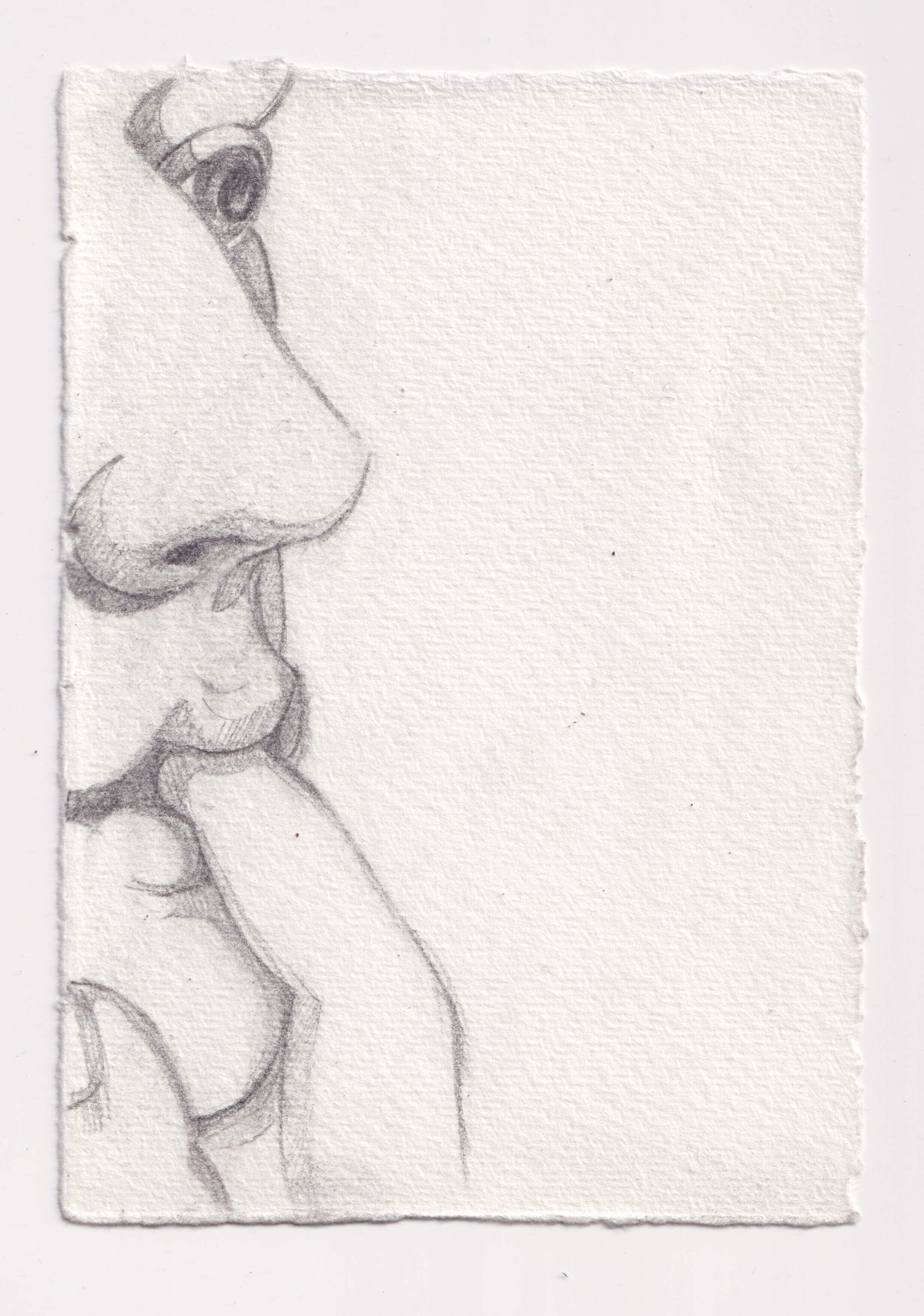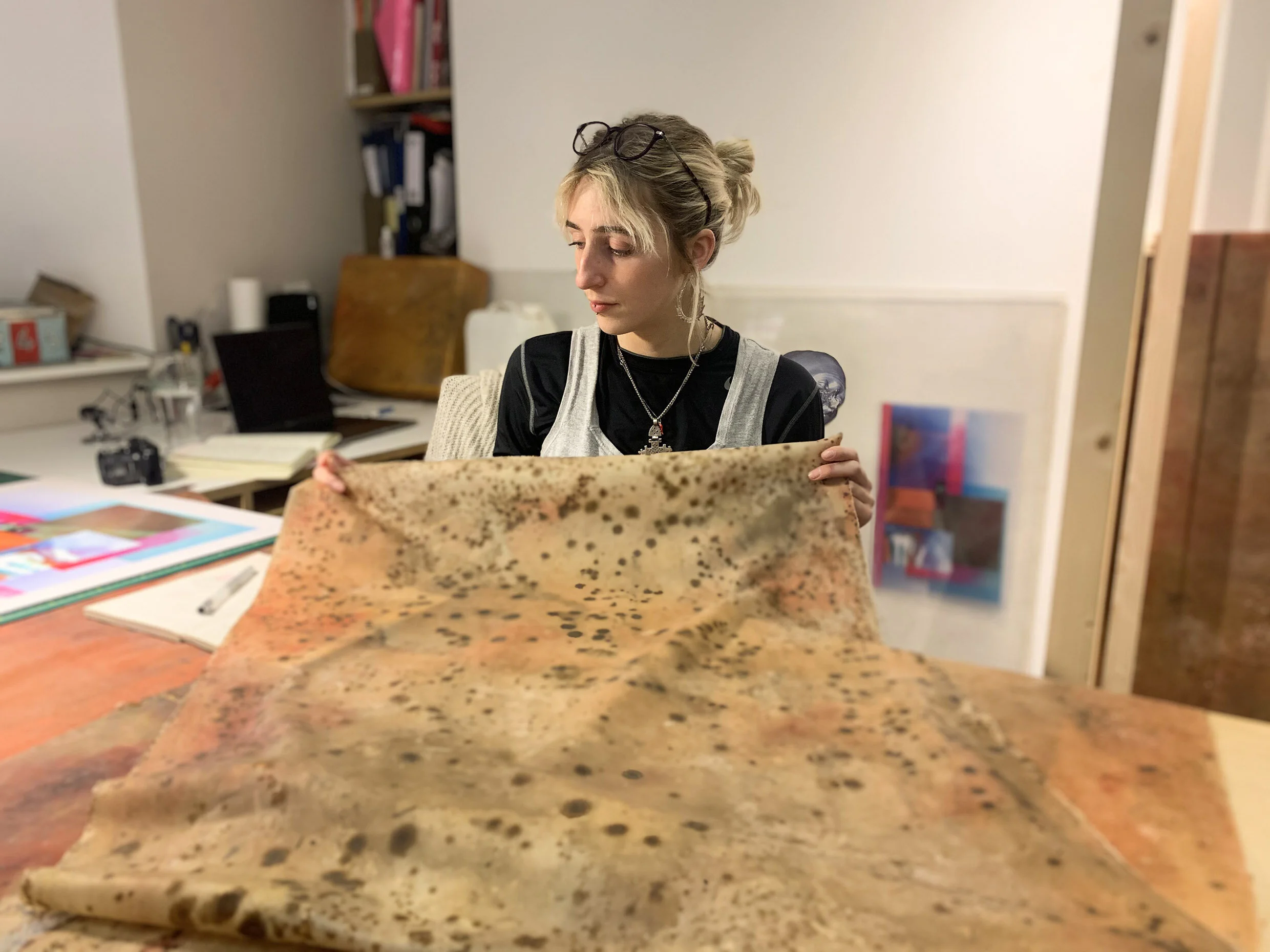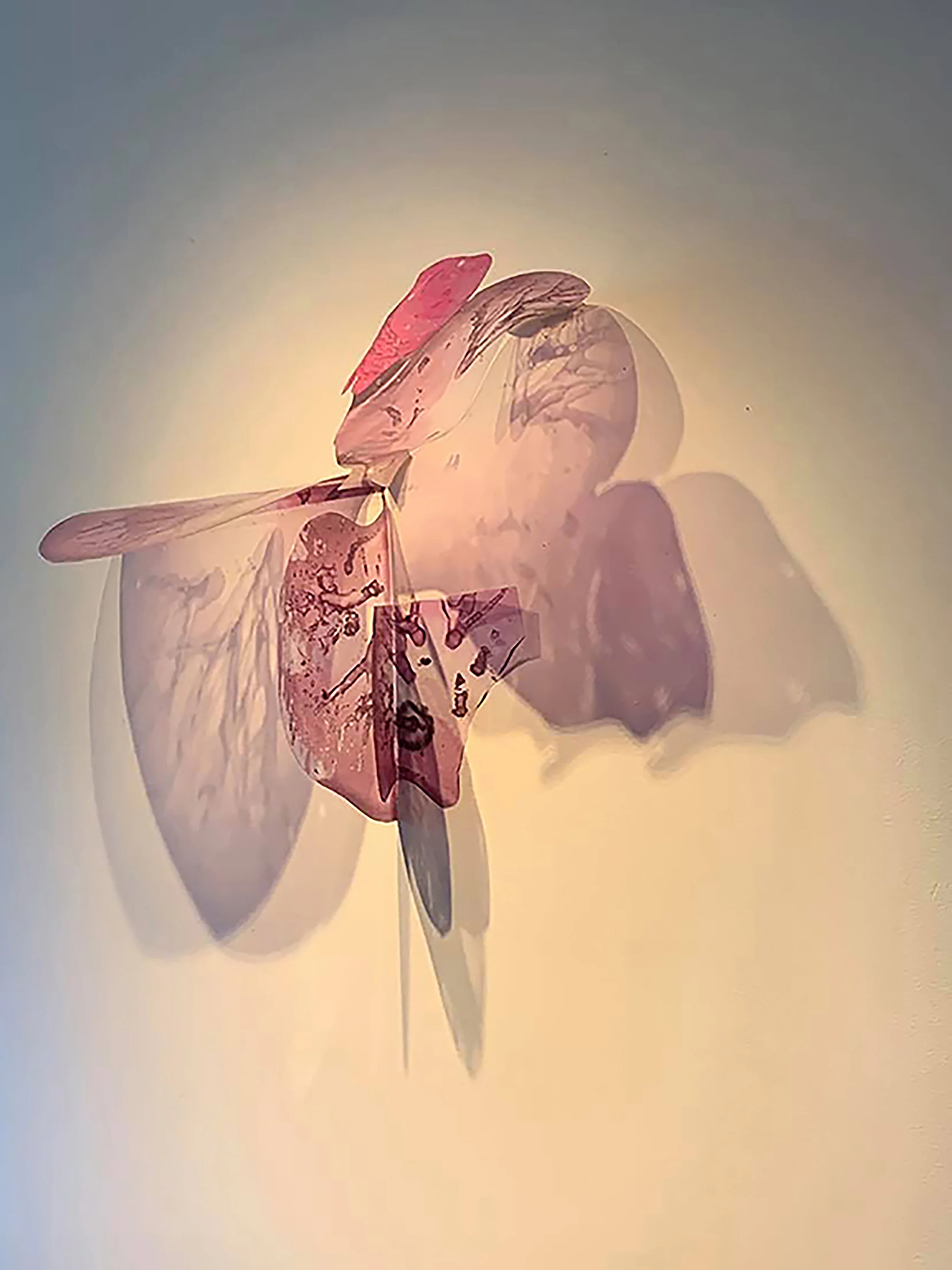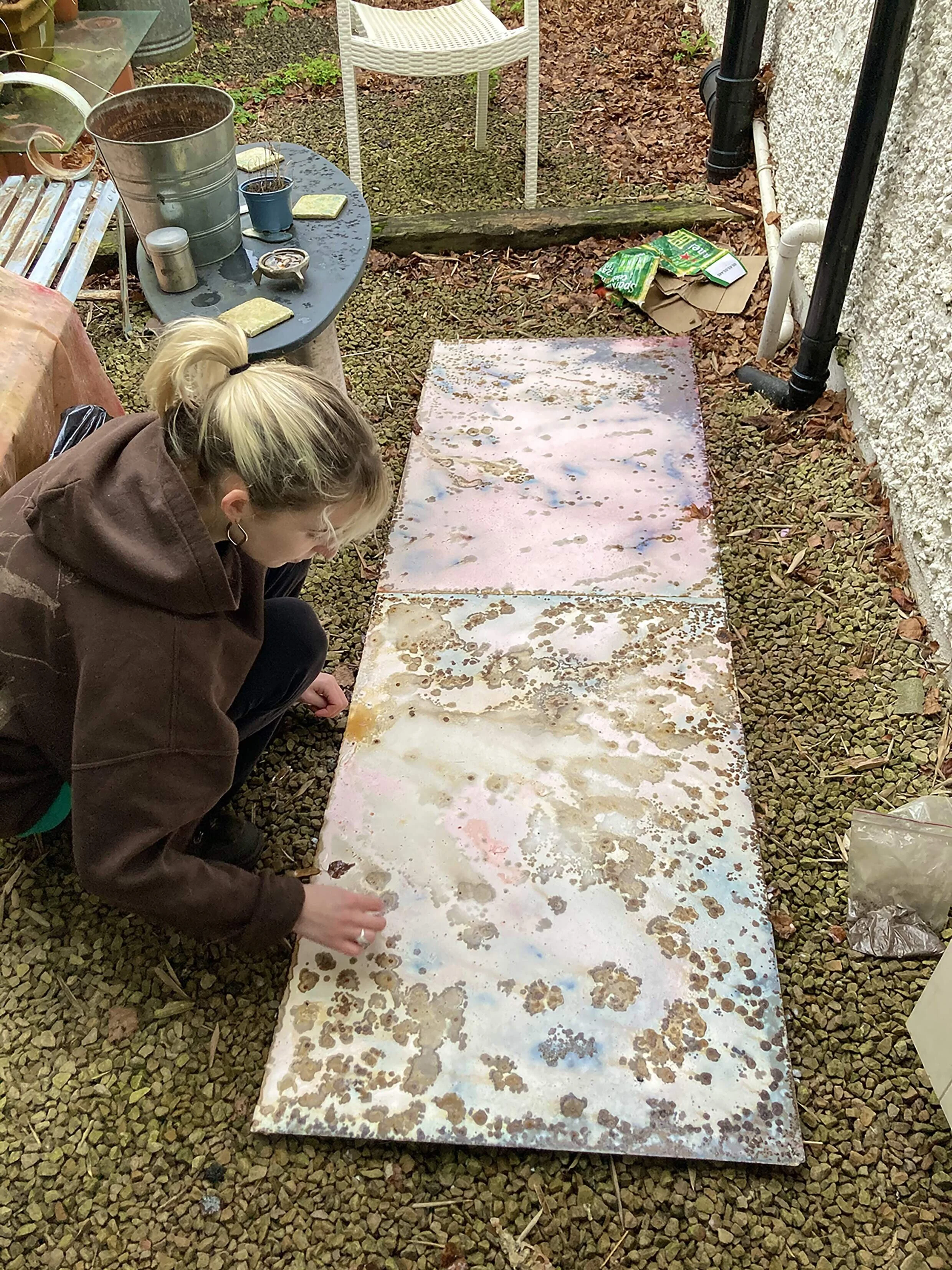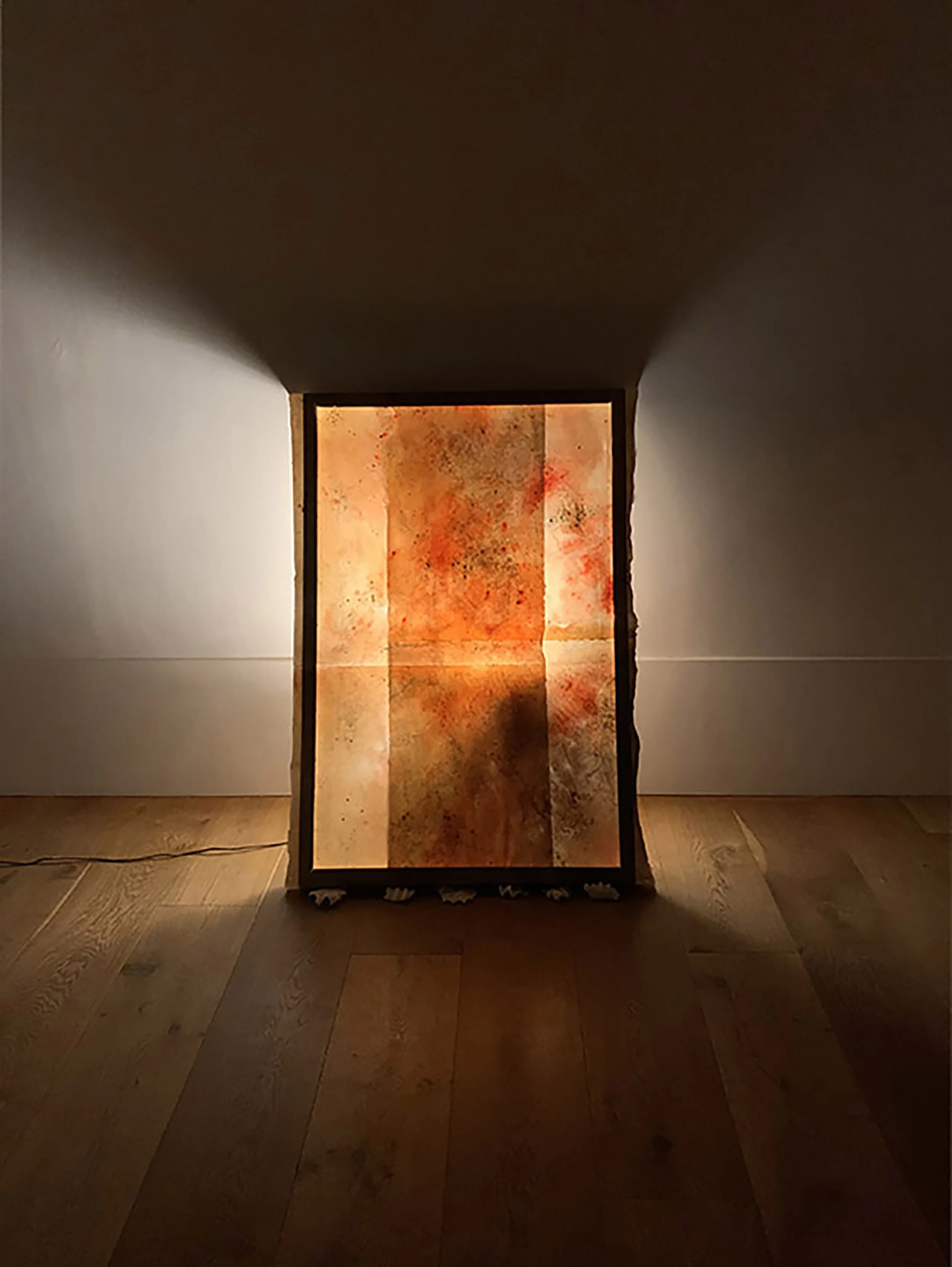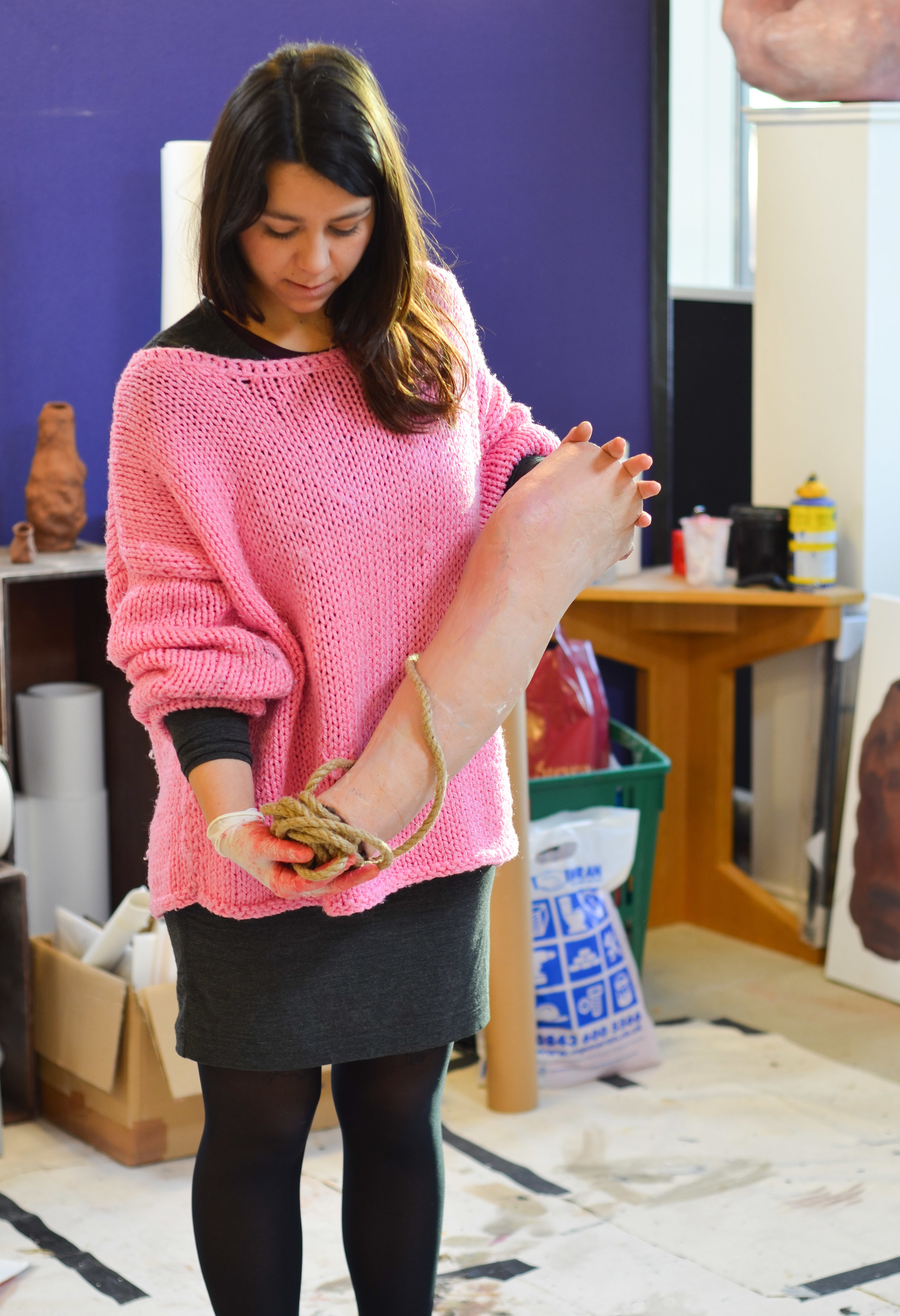Bethany Marett in her studio, photo courtesy of the artist
Damaris Athene: Could you start off by telling me a bit about yourself?
Bethany Marett: So I grew up in Preston, Lancashire, and I actually studied History of Art for my undergraduate degree at York. But after working in galleries, I decided I wanted to be on the other side and to be an artist rather than art historian. That was my excuse to move to London and do fine art. 10 years ago I did a summer foundation course at the Slade, which was really intensive and was just amazing. I couldn't afford to do another BA so I took different art courses in London and joined a printmaking studio and was elected to join a printmaking cooperative. I worked independently until I went to the Royal College of Art and did Print for my Masters in 2016. Since then I've had a studio at Thames-Side for the past two years, it’s near Woolwich in London. My work is a mixture of sculpture, print, and photography.
DA: Were you making work throughout that time, when you were studying art history?
BM: Yeah, but quite different work because I wasn't really involved in the contemporary art scene. I had more traditional influences. I've always done life drawing and I find that really underpins my practice. Definitely the theme of bodies has always been there. I didn't really start making sculpture or more abstract work until the Slade.
DA: It's so different when you're making without that critical framework or understanding of what else is out there. It's amazing that you made that leap from history of art and you came to making art.
BM: It was quite difficult at first, because having studied History of Art, initially it felt like everything had already been done. You've got this whole weight of art history on your back, and also as we only really studied up to the 1980s, contemporary art is a whole different world.
DA: Only going up to the 80s feels like ancient history! Would you be able to say a bit more about your practice? So you've already mentioned it’s connected to bodies, but could you elaborate on that?
BM: I describe myself as multidisciplinary because I do work in quite a lot different mediums. I'm quite driven by material and I'm interested in process. Coming from a printmaking background, there are a lot of processes there and I enjoy that technical side of things. My prints are quite different to my sculptural work, they are much more figurative. With the sculpture I feel much more free to be more abstract. The body is a link to everything, skin, this idea of vulnerability, sensuality. It's always coming from quite a personal place. I usually use myself to make my work by casting my own body. Bodies and people are endlessly fascinating and in particular your relationship with your own body is always changing.
‘Hunk’ 2020, Plaster and resin
30cm x 26cm x 28cm
Photo courtesy of the artist
DA: So true. What initially drew you to making work about the body?
BM: I think it's a combination of things and maybe an innate squeamishness? The human condition and the reality of our mortality; what we see is our skin but below that, you're made of flesh and bone and veins. There’s a tension there. Also coming from quite a religious background, definitely there’s some repression. I'm always trying to express the thing that bodies can be beautiful, but at the same time, quite repulsive. I’m trying to convey the duality within that.
DA: I connect with that so much. As you know, my work is exploring really similar things. I think that duality is fascinating, how it can be one thing and then the other. And also thinking about the skin as a permeable membrane or barrier that covers up all the gore, but things can still go through it and be absorbed by it.
BM: Yeah, completely. Often my work is the body from the inside looking out. So thinking about the negative spaces, or spaces around things, or gaps around the body.
DA: I guess that's connecting to how you're saying it's about intimacy in your own body? You know, how can you ever convey the experience of being in your own body to someone else? And just thinking about your work and how it's personal, obviously, you're a woman and I was interested in the first time that you really became aware of how women's bodies are represented in the media and wider society.
BM: That's a really hard thing to pin down because as long as I can remember I've always really hated my body and have always wanted to change it. I think it was just pervasive, to be honest. The culture of skinniness, dieting and that women are meant to criticise each other's bodies or self-criticise. In magazines you'd see pictures of celebrities with a circle pointing out their tummy fat or a double chin. I couldn't say when the first time was because I’ve just never known anything else.
DA: It's so insidious.
BM: Yeah, it is. It's really sad. Moving to London helped me as it was a much more multicultural society than what I knew, and people don't seem to care about what everyone else is wearing as much. It feels less judgmental here. And after turning 30, just being more comfortable with myself. Now I'm more angry that women in particular, it affects men as well I'm sure, but that we're encouraged to devote so much wasted time, energy, and money into feeling that way about ourselves.
DA: It's crazy. Isn't it? Just the amount of mental space it takes up and the amount of time. I don't wear make-up anymore and one main reason for that is that I don't want to spend time on that.
BM: Why should you?
‘Proxy’ 2018, C-Type mounted on aluminium with subframe
122cm x 91cm
Photo courtesy of the artist
DA: Very true! So I was thinking about the way that your work sits between abstraction and figuration. What potential do you think there is by sitting within that liminal space?
BM: I'm trying to leave space for the viewer to use their imagination, their mind's eye and to leave a space open for interpretation. My work definitely has a figurative element to it, but it can appear abstract. This gap is where I want the viewer to look closely, to scrutinize, to maybe see pores, follicles, or hairs, and I hope it adds an element of intrigue as well. It gives the chance for the viewer to see what they want.
DA: Yeah, and the opportunity to be drawn further into it. If you instantly recognise something it can lose that intrigue.
BM: Exactly. You don't want to give them an open book. I want them to take their own little journey of discovery.
DA: Definitely. And you work with quite a lot of different mediums. What will dictate what medium you use?
BM: I think I'm just really curious and experimental in my practice. I want to try it all. I use plaster, resin, silicone, and latex. You can find bodily qualities within them, and they have this liquidity. Actually, the material might come first and prompt the work. Other times I'll have the idea and find the right material for it. I have never been a person who sticks with one thing.
DA: And what about with printmaking because it's such a process heavy thing, it's quite hard to be more loose with it as you need to plan a bit more. How do you find the difference between working with sculpture and then working with printmaking? I guess with casting, you've got to plan a lot too.
BM: I think there are quite a few parallels. There are a lot of stages to mould-making and casting. Since lockdown I've been doing things like reduction woodcuts which are really quite slow and you really have to plan out the different stages, what colour is going to go on top and what are you going to cut away next. It’s been quite methodical. I think that suits me.
DA: When you're developing the sculptures and preparing for that very methodical process of casting, are you drawing? Are you making little maquettes? How did the ideas develop for the forms that you go on to cast?
BM: The sculptures don't really start with drawing actually, it's more just playing with the material. A lot of the time I pour the plaster directly onto myself and, because I'm working with a negative space, I can't really know exactly how it's going to come out until it's set and it comes off. Other times it’s more planned. I made a work a few years ago casting my ‘non-thigh gap’. There was this trend on social media about being skinny enough to stand with your feet together and have a gap between your thighs. I've never had a gap so I wanted to see what's there instead. It turns out to be a quite interesting shape, like a shark's fin.
‘Fin’ 2019, Lacquered Pewter
26cm x 5cm x 21cm
Photo courtesy the artist
DA: That’s so interesting! Do you find it difficult casting your own body?
BM: *laughs* Yeah, it's quite hard. Sometimes I have an assistant. There's definitely a performative element to it, sitting there very still, trying not to move.
DA: *laughs* Do you feel that your practice has developed and changed a lot since you left the RCA in 2018?
BM: Yeah, I think so. I mean, when I was at the RCA I was spoiled with the amount of facilities and workshops. We were encouraged to be experimental and try new things. Now it’s a lot more difficult to make work and it's not as cheap. It's more of an investment for sure. For a while I’ve worked with plaster and resin, partly because it was something I could do by myself. Being out of university has been quite freeing as well though, because there's a lot of pressure when you're studying for an MA. You have conversations all the time and crits, and tutorials. You really scrutinise everything you make, which is really good for the learning process, but it's also quite nice now that I don't have to do that! I can have crits and conversations about work and actually, I think after being locked down, we do really need them. It's a double-edged sword, you need the conversations, but it's also nice to not have to feel like I've got to justify every single thing I make. You learn about your work through talking about it with other people.
DA: Definitely! Has the pandemic changed the way that you work?
BM: Yeah, totally. Without those conversations you're left wondering if something is good or not? Is it fulfilling what I wanted it to? Also, limiting the travelling to my studio meant there was more pressure when I was there, so I've been making work from home as well. Being on furlough meant having more time to do things and I've been trying to up-skill as well. I recently did a Jesmonite course and woodworking course. I've been trying to use this time to equip myself with more skills, learn about new materials.
DA: That sounds great! What would you like people to get from your work when they experience it?
BM: I hope people can relate to my work, or that it can somehow change the way that they think about something, or at least just think it's interesting. I'd like to make work about women's bodies that I haven't seen before. Because, you know, women's bodies have been represented over and over again throughout history. I want to show them in ways that are unexpected and haven't been already done. I'd like to tackle in some way societal change and make work that's empowering rather than destructive.
‘Perpetual Rolls’ 2018, Copper electro-plated bronze
30cm x 24cm x 8cm
Photo courtesy of the artist
DA: As you say, it's been something that's been done so many times so it’s hard find a unique take, but for me your work does achieve that.
BM: Aw, that's really kind.
DA: Have you ever had a really interesting or surprising response to your work?
BM: Yeah, a couple of years ago I was in an exhibition for blind or visually-impaired people called the Touch Tour. It was organised by an artist, Teresa Hunyadi, at Edinburgh Sculpture Workshop. I exhibited my pewter Fin piece and it was such a fascinating thing to be involved with, seeing people read your work without using their eyes and through touch instead. I'm very interested in the tactile, and the different textures and materials that I use are really important. A lot of my work is about trying to make the viewer want to touch it.
DA: What an incredible thing to be part of.
BM: It was great. All the people that came were so grateful to be able to experience art in a way that they can't normally. I think particularly as it was sculpture, it's not something that is just for the eyes, it’s for the body. You can walk around it, you can bend down to see it, it confronts you like a body.
DA: Could they tell that it was connected to the body?
BM: Yeah, they could. They could definitely interpret it just as well, maybe even better, but in a different way.
DA: I guess it’s like a bit of their body that they would have touched and will be familiar with. I hope you get to do it again sometime! I’m also interested in which artists inspire you.
BM: The first one I'd have to mention is Alina Szapocznikow, who was Polish artist. She was amazing. There was a recent retrospective of her work at the Hepworth in Wakefield. I don't think I came across her long before that. Her work is sad, feminine, sexual, quite fetishistic, quite surreal, but also beautiful and uncomfortable. Then also Jala Wahid. She's also working with this tension between work that's inviting and grotesque and also quite surreal. Her use of materials is really interesting, making sculptures using untypical materials, and she makes casts as well. She makes quite dark things, there are definitely undercurrents of violence there. One more is Alice Channer.
DA: She has a really interesting use of materials too.
BM: Yeah, blurring the natural and the artificial.
DA: I can definitely see that connection with your work, thinking about the natural and the body.
‘Trunk’ 2021, Silicone and Chondrus Crispus red algae
29cm x 28cm x 43cm (back view)
Photo courtesy of the artist
BM: For my recent piece ‘Trunk’ I put seaweed that I collected from Brighton beach inside silicone. Women's bodies have always been associated with the earth and with water, since ancient Greece. I wanted to exploit that link.
DA: What projects are you working on at the moment?
BM: I finished ‘Trunk’ a couple months ago for an exhibition in Dorset at Thelma Hulbert Gallery. It should happen in the autumn. I think it's the third time it's been postponed! Last year I was elected to join an artists collective called The London Group and it's a show with them. I’ll be showing with them in the summer too, in Waterloo.
DA: Great!
BM: In September, I’m going to be starting a ten-month Artist in Residence role at a school in Oxford, which will culminate in a solo show in July next year so that’s going to be an exciting adventure. I’m looking forward to getting back into the swing of things though. I’ve been taking stock in this time and have enjoyed having less pressure.
DA: Do you have any plans for future work?
BM: Lockdown showed how important public artwork is and last year I was meant to be in an exhibition, an outdoor sculpture trail, which sadly got cancelled. For that I was experimenting with plaster based work that can be shown outside, but now I can use Jesmonite which is weatherproof. Also, because a lot of my stuff is from the body it's all life size, and I want to work with scale. How increasing scale can change meaning, like if you're seeing the surface of skin a lot bigger than what it actually is. It's quite difficult because surface is really important to me and you only get that exact texture from casting. Maybe I'll have to 3D scan small work and enlarge it or create the texture by hand.
DA: I'm very excited to see what you make and I hope I’ll be able to catch the show! Thank you so much Beth, it was lovely to meet you.
BM: Thank you!













































